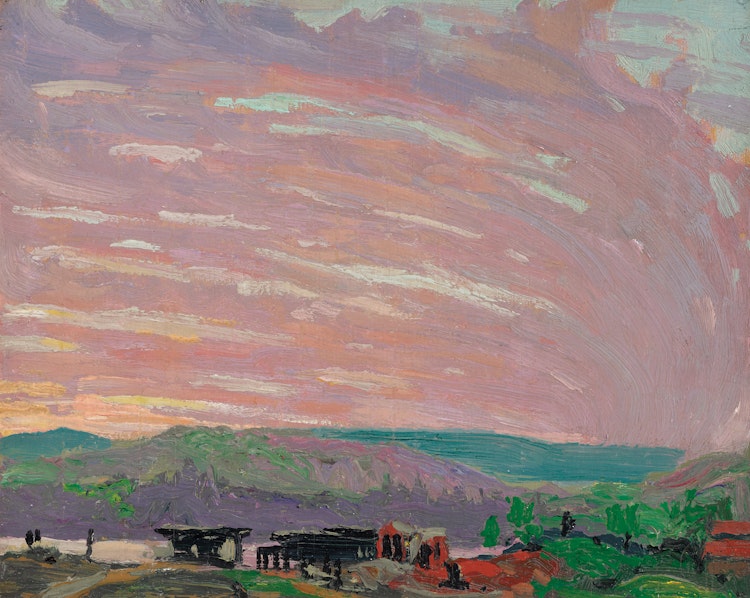Spring, Algonquin Park by Tom Thomson

Tom Thomson
Spring, Algonquin Park
oil on board
artist estate stamp lower right; catalogue raisonné no. 1914.45
8.5 x 10.5 in ( 21.6 x 26.7 cm )
Auction Estimate: $700,000.00 - $900,000.00
Price Realized $720,000.00
Sale date: May 30th 2024
Laing Galleries, Toronto, circa 1942-1943
The Rt. Hon. Malcolm MacDonald, Ottawa and Kent, England
Private collection, Ottawa
Joyner/Waddingtons, Toronto, auction, 1 June 2004, lot 51
Private Collection, Vancouver
Private Collection
"Tom Thomson (1877-1917), Annual Loan Exhibition", Galerie Eric Klinkhoff, Montreal, 5-19 November 2022, no. 14
Thomson to F. H. Varley, 8 July 1914
Malcolm MacDonald conversation with Joan Murray, early 1970s
Joan Murray, 'Tom Thomson's Letters' in Dennis Reid, Charles C. Hill, "Tom Thomson", Vancouver/Toronto, 2002, page 298, the related work "Canoe Lake, Mowat Lodge" appears on page 183
Joan Murray, "Tom Thomson Catalogue Raisonné", entry 1914.45, 2016, https://www.tomthomsoncatalogue.org/catalogue/entry.php?id=219 (accessed on 12 March 2024)
Thomson painted this work at a height slightly above and at a distance from the main building, a view he favoured though he must have been further away in a closely related work, "Canoe Lake, Mowat Lodge", Summer 1914 (Tom Thomson Gallery, Owen Sound) which more clearly shows Mowat Lodge, its outbuildings and setting. Both sketches are confident and powerful, proof that Thomson was happy in his surroundings in Algonquin Park and the daring experiments with colour, form, and structure he did there which would change the course of Canadian painting.
He painted these works in the summer of 1914. In the spring, summer and fall of that year, his work made a clear progression towards more vigorous brushwork and confidence in colour and form. That March, "Moonlight", a major canvas had been bought by the National Gallery of Canada, which meant a huge boost to his self-assurance, as did his election to the Ontario Society of Artists the same month.
In late April he travelled from Toronto to Algonquin Park, where Arthur Lismer soon joined him for a camping trip. On the heels of dropping Lismer off to go home, Thomson went to Georgian Bay for two months to stay with his friend and patron, Dr. James MacCallum and his convivial family at their cottage on Go-Home Bay, but found the “all birthday cakes and water ice” atmosphere uncongenial to him.
He returned in early August to “Camp Mowat” in Algonquin Park, likely with a feeling of relief, where he painted these works. They were his way of telling himself ‘welcome back’ to the place where he felt happiest and his joy at returning shows in the sketches he painted.
He had begun painting skies early in his career and delighted in the soaring shapes of clouds when he journeyed to Georgian Bay, as seen in works such as "Split Rock Gap, Georgian Bay" (location unknown). That summer of 1914 he began to record sunsets and the colour of the sky at dawn and dusk, even swirling skies as in "Hills and Swirling Sky" (National Gallery of Canada). It was a feature which became an established part of his practice but rarely as brilliantly painted as in "Spring, Algonquin Park".
G. Blair Laing, the dealer who sold the work, titled the painting inaccurately on a label, as “Spring”. He sold it to the distinguished British politician, diplomat, and colonial administrator, the Rt. Hon. Malcolm MacDonald, who was High Commissioner to Canada from 1941 to 1946. MacDonald was also an important collector, particularly of artwork that reflected the culture of his postings. Throughout MacDonald’s career, his passion was ceramics and today, The Malcolm MacDonald Collections are held by the Oriental Museum at the University of Durham in England, as well as by other museums, such as the National University of Singapore Museum. But he was a collector of a variety of genres, and one artist he collected was Tom Thomson.
MacDonald loved Thomson’s work so much so that he owned four works by him: "Spring, Algonquin Park, Missisagi" (Private Collection); "Twilight Woods" (Private Collection, Winnipeg) and one other that he lost during a move in England (he thought the movers might have taken it). He remembered the work well and in the early 1970s described it to the curator at work on the catalogue raisonné of Thomson: “It had a flock of wild ducks in flight on their migration south in the sky,” he said, “and I’d like it back.”
We extend our thanks to Joan Murray, Canadian art historian, for contributing the preceding essay.
Share this item with your friends
Tom Thomson
(1877 - 1917)
Tom Thomson was born near Claremont, Ontario and grew up in Leith, near Owen Sound. After moving to Toronto, his early career was spent as a commercial artist at Grip Ltd., the commercial design firm where he first met MacDonald, Harris, Jackson, Lismer and others. By 1911, Thomson was making regular sketching trips to areas north of Toronto and, in 1912, he made the first of many trips to Algonquin Park.
As well as being an artist, Tom Thomson was an avid outdoorsman and Algonquin Park soon became his favourite place to paint. His enthusiasm for its quiet, untouched landscape with its changing moods and bright fall colours inspired other artists to explore the region. After 1914, Tom Thomson spent most of his time painting in Algonquin, except during the coldest winter months. It was during this period that he produced the bulk of his paintings of this rugged northern landscape. Thomson's brief, but prolific, career as an artist came to a premature end when he drowned in Canoe Lake in 1917, just three years before the Group of Seven held their first exhibition. His artistic achievement was to remain an inspirational force to other Group members.

